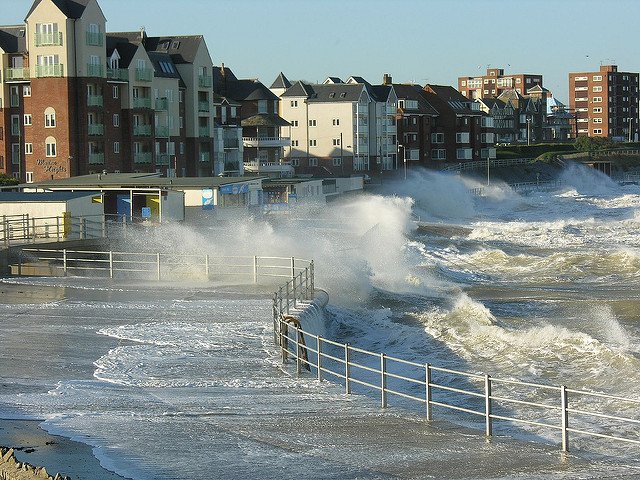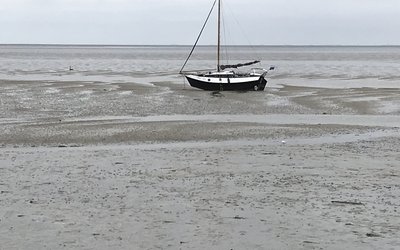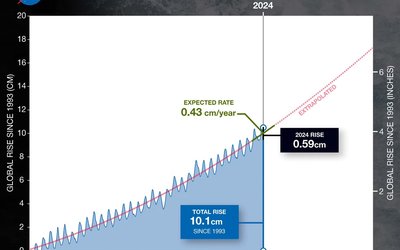Coastal erosion and coastal floods
Extreme sea levels on the rise along Europe’s coasts
July 16, 2017

High tide at Westgate on Sea (England) (photo: Max Montagut, www.flickr.com)
Sea level rise is not the only factor that drives changes in future coastal flood risk. Astronomical tide and episodic water level fluctuations due to climate extremes (storm surges and the set up by waves when they shoal and break at the coast) are important components as well. These components will also change along with sea level rise as a result of climate change. The combination of these factors should be considered, therefore, to assess future changes in extreme sea levels along Europe’s coasts and the resulting impact on coastal flood risk.
Results of the first pan-European assessment of the evolution of extreme sea levels in view of climate change were published recently, considering all driving components. The results are based on projections by a large number of climate models for the end of this century considering two scenarios of climate change: a moderate and a high-end scenario (the so-called RCP4.5 and RCP8.5 scenarios). For this study the European coastline was divided in 10 geographical regions in order to identify spatial patterns in the data.
Relative sea level rise
Relative sea level rise is the rise of sea level with respect to land and thus combines absolute sea level rise with land subsidence and uplift. According to the study relative sea level rise is projected to increase along Europe’s coastline by around 21 and 24 cm by the 2050s under the two climate change scenarios, respectively, to reach 53 and 77 cm by the end of the century. Projected sea level rise is highest along the North Sea and Atlantic coasts, followed by the Black Sea, and smallest for the Baltic Sea due to land uplift in this area.
Tide, storm surge and wave set up
The combination of storm surges and wave set up shows no or minor changes along most of the southern European coastline, apart from an important decrease that is projected for the Portuguese coast and the Gulf of Cadiz, where the once-in-a-hundred-years effect of storm surges and wave set up combined may be 5-12 cm lower in 2050 compared with the current situation and 10-20 cm by 2100. In most regions of northern Europe, an opposite trend emerges: the projected once-in-a-hundred-years effect of storm surges and wave set up combined may increase around the Baltic Sea, and along the North Sea coasts of northern Germany and Denmark up to 35 cm by 2100 under the high-end scenario of climate change.
The projected change of tidal elevation is negligible for the entire European coastline.
Once-in-a-hundred-years extreme sea levels
The combined effect of sea level rise, astronomical tide, and storm surges and wave set up on the once-in-a-hundred-years extreme sea levels along Europe’s coasts is a rise by around 25 cm on average by 2050 under both scenarios, and a rise by 57 cm and 81 cm by 2100 under the moderate and high-end scenario of climate change, respectively. Strongest rise was projected for the North Sea region with increases up to 75 cm and 98 cm by 2100 under these scenarios, respectively. A similar increase is projected for the Atlantic coasts of the UK and Ireland, and considerable increases are projected for the Norwegian, the Baltic, and the Mediterranean Sea.
The results show that future extreme sea levels along Europe’s coasts are mainly driven by relative sea level rise. Averaged over Europe, the contribution of future changes in storm surges and wave set up is less than 20% of the contribution of relative sea level rise. Storm surges and wave set up may contribute much more to extreme sea levels in some parts of Europe, however; especially for the Baltic Sea (65% and 35% by 2050 and 2100, respectively), and to a slightly lesser extent for the North Sea. Along the Portuguese coast and the Gulf of Cadiz, an opposite effect emerges: the contribution of storm surges and wave set up is projected to decrease with 30% by 2050 and 20% by 2100. According to this study, the effect of sea level rise on tides is negligible. This does not agree with findings in other studies, however, that show that sea level rise can affect tides locally.
Coastal flood risk
The results of this study indicate that the 5 million Europeans currently at risk to be flooded by sea water once every 100 years, may be flooded almost annually by the end of this century under a high-end scenario of climate change, and every 2-3 years under a moderate scenario of climate change, unless appropriate adaptation measures are implemented in time.
Source: Vousdoukas et al., 2017. Earth’s Future 5: 304-323








